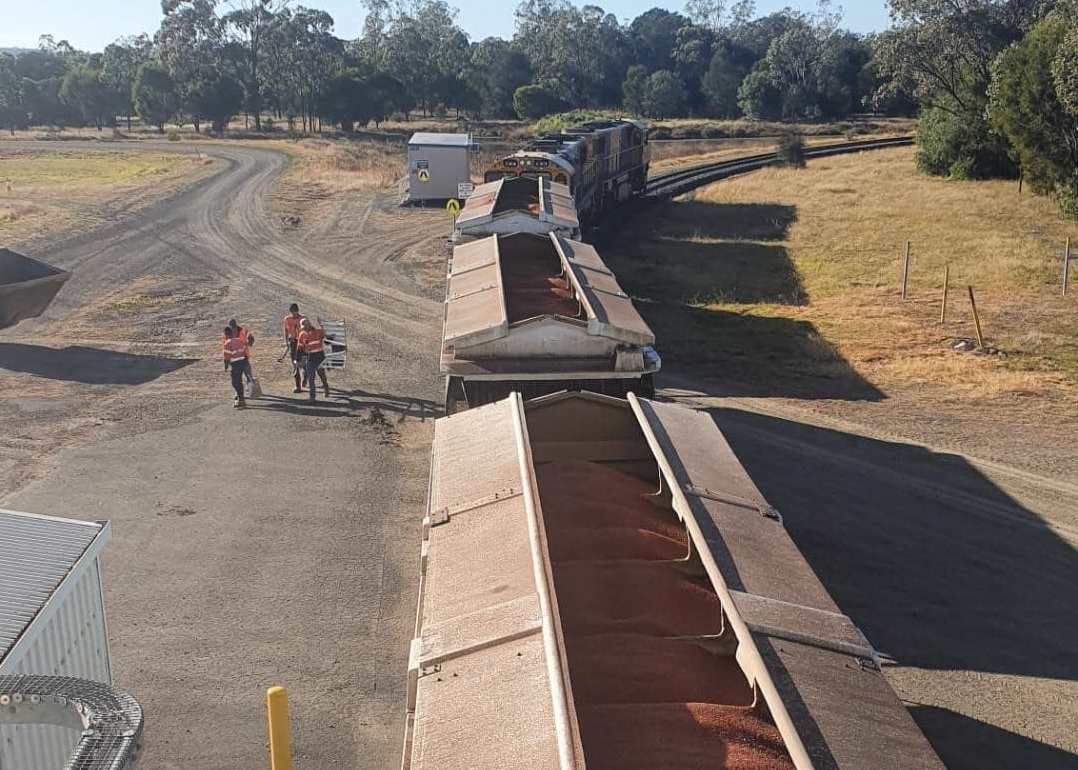
Sorghum is loaded on to a train bound for the Port of Brisbane at Jondaryan on the Downs this week. Photo: CHS Broadbent
PRICES for wheat and barley have fallen in the past week as grower interest in selling current-crop surges on the eve of the new financial year, and new-crop selling interest ramps up amid solid production prospects around the globe.
It has meant growers have become keen to clear their silos and push grain into export pathways before the Northern Hemisphere new-crop hits the world market.
Many consumers are already covered for July-September, and are therefore providing little competition for export accumulators.
Most consumers have started booking up some new-crop tonnage, and it appears big carryovers in the New South Wales and Brisbane port zones are weighing on buyers’ price ideas.
| Prompt today | Prompt Jun 23 | |
| Barley Downs | $440 | $460 |
| SFW wheat Downs | $445 | $470 |
| Sorghum Downs | $370 | $385 |
| Barley Melbourne | $425 | $430 |
| ASW wheat Melb | $455 | $465 |
| SFW wheat Melb | $450 | $460 |
Table 1: Indicative delivered prices in Australian dollars per tonne.
Full flow in north
Improved logistics and fine weather in the past week have seen the market consolidate at lower levels as production prospects and nearby availability improve.
Higher-grade sorghum continues to pour into the bulk export pathway, with delivered port prices at around $395-$400/t, down $5-$10/t in the past week.
While some growers are still battling boggy conditions to get winter cereals planted, most wheat and barley crops in Queensland and northern NSW are now in the ground, and growers and consumers are starting to trade new crop.
Delivered Downs barley for January-February has been booked this week at $380-$385/t, with wheat at $410-$415/t.
“We’ve seen a lot more grower liquidity in the past two weeks,” one trader said.
“Growers are ready to talk, but we’re not going to pay $435 for barley now if we can get it for $380 in January.
“It’s been a sellers’ market all year and now it’s a bit of a buyers’ market.”
“We’ve seen a reaction globally based on how things are looking in the Northern Hemisphere.”
The downturn has some bulk handlers offering grain to consumers from sites well away from port as export terminals remain heavily booked.
Cottonseed weakens
Global oilseed values have fallen in the past month based on an improved supply outlook and the likely tempering of world demand in this inflationary period.
Cottonseed prices have followed suit, and Woodside Commodities broker Hamish Steele-Park said prices have dropped $10-$15/ in southern NSW and $5-$10/t in Queensland and northern NSW.
“Drier weather over the past couple of weeks is allowing cotton picking to push on, although it’s slow going with shorter days.”
“Export demand has tempered a little this week with the global oilseed sell off,” Mr Steele-Park said.
Global lint prices have also fallen sharply in the past week, as evidenced in the ICE (Intercontinental Exchange, Inc) price decline.

US Cotton #2 futures December contract lost quarter of its value in the week to 28 June. Overnight it recovered 4pc. Us cents per pound. Source: ICE futures.
South falls more modest
Price drops in the south have been more modest than those in the north this week for nearby wheat and barley as growers prove reluctant to follow the market down.
“The bid side has fallen out of bed, and the offer side is trying to hold its dignity,” one trader said.
“There’s a big spread between the bid and offer, and the trade’s not interested.”
The trader said southern consumers were comfortable with July-September coverage, but the hefty export program could generate some demand for October-December deliveries, especially if harvest is late.
“The back end of the year gets tight in Vic.”
In South Australia, Pinion Advisory commodity risk manager Chris Heinjus said old-crop stocks were reasonably tight, and while grain in NSW looks attractive to consumers and exporters, logistics remains a challenge.
“Domestically, people are going to look at where they can manage long-haul freight out of NSW,” Mr Heinjus said.
“In the Port Adelaide zone, the challenge is logistics: Can you put a truck under a spout in central NSW?”
Mr Heinjus said crops in many districts of SA, including Mambray Creek north of Port Pirie, are running later than normal because they were planted in the back half of the ideal window.
“That means someone looking for new-crop grain in October might be getting it in late October.”
“It depends on the timing of new crop, but there’s potential for some shorts to appear around export demand overriding the domestics.
“I think we are going to go into harvest with a lot less stock than there is in NSW.”
Mr Heinjus said some traders were buying old crop as a hedge to what could be a tight supply in the opening weeks of the new crop year, and a little new-crop trade was taking place.
“We’re seeing a little bit of interest in new-crop at $450-$460/t for multigrade wheat, but the reality is it was $490 not so long ago, and the farmer is not that keen to engage now.”

HAVE YOUR SAY